
The president-elect and his transition
team must make effective use of the time between Election Day and
Inauguration
Day so as to "hit the ground running."
Transition Nuts and Bolts
After the excitement of
Election Night, it is time to turn attention to building a new
administration.
In fact, preparation for the transition has been underway,
quietly,
for some time. During the latter part of the campaign, both major
candidates designate people to head up the transition planning, and the
outgoing administration take steps as well.
Now, however, it is the
real
thing. Amid euphoria and exhaustion, responsibility looms.
Expectations are high. The one-time candidate must assume a
"presidential
aura." The president-elect and his transition team must make
effective
use of the time so as to "hit the ground running."
Charles Jones, a
visiting
fellow at the Brookings Institution, has an interesting way of
describing
the process. He notes that the campaign is centered around one
person,
the candidate. After the campaign, the challenge is "attaching
that
person to the government." The transition requires skilled
management.
A certain amount of tension in
this
period is inevitable. People who have worked hard on the campaign
now see others being brought in to manage the transition. There
is
much jockeying for position, various constituencies make their cases,
and
resumes proliferate.
The transition is not
only
the beginning of a new administration, but the end of an old one.
Handing over the reins of power requires considerable preparation on
the
side of the outgoing administration. The new team must be
briefed;
records must be boxed and filed. During its waning days, the
outgoing
administration will also endeavor to get as much done as possible,
attempting
to produce some last accomplishments to add to its legacy and making a
final round of appointments, executive orders, regulations, and pardons.
The president-elect's
Cabinet
selections make headlines, but in the transition office the focus is on
the nitty gritty of building a new administration. Careful
attention is given
to selecting sub-cabinet personnel, learning about the pending issues
in
various agencies, and figuring out what policy initiatives to
advance.
Myriad sub-Cabinet posts must be filled, including deputy secretaries
and
agency heads. The White House staff also takes shape. There
is no shortage of aspirants for positions in the administration; the
transition
office will receive tens of thousands of resumes. Care must also
be taken to avoid early flaps which can undercut the fledgling
administration's
effectiveness and support.
Senate confirmation
hearings
of Cabinet nominees begin in relevant committees. Each nominee
will have a team to guide him or her through
the
confirmation process; there are policy, legal, press and congressional
affairs aspects to consider. Traditionally the Senate will not
block
a nominee unless he or she has ethical problems or is not qualified.
The Obama Transition
As noted transition planning had been
going on for
some months; transition co-chair John Podesta stated, "We really began
in early August." The day after Election Day, November 5, the
Obama team announced its transition
leadership, and the General Services Administration
handed over the keys to office
space in downtown DC; there is also space in the Federal Building
in Chicago. At
a briefing on November
11, transition co-chair John Podesta said the Obama-Biden
Transition Project, which is organized as a 501(c)(4),
would ultimately have a staff of about 450 people and a budget of $12
million. (The actual numbers were a bit lower).1
Congress appropriated approximately $5.2 million;
the transition organization raised the remainder, eschewing money
from federal lobbyists and establishing a $5,000 limit. (Through January 15, 2009, a total
of $4,490,065.76 had been raised from 59,609 donors).
Podesta promised "the most open and transparent transition in
history." As a start, he announced "the strictest, and most far
reaching ethics
rules of any transition team in history." In early December,
Podesta further announced a "seat
at the table"
policy wherein "any
documents from official meetings with outside organizations will be
posted on our website for people to review and comment on." The
transition also reached out to Americans, for example encouraging
people to submit their ideas through its website, and asking people to
hold "health care community discussions" in the latter half of
December. The
transition also held several rounds of "Open for Questions;" about 20,000 people
participated in the first, 10,000 questions were submitted, and a
million votes were cast on which questions to answer. In the second
round,103,512 people submitted 76,031 questions and cast 4,713,083
votes.
In terms of the
type of people Obama would select, Podesta said that "excellence is the
first criteria."
Obama intended to reach out and have Republicans and Independents "not
just at a token level," Podesta said. "His commitment is to
deepen that." Podesta also said the Obama team would work to
accelerate the confirmation process as much as possible. While
senior Cabinet level appointments draw all the attention, they may
arrive at their departments and agencies to find sub-Cabinet positions
unfilled. "We need to do a lot better," Podesta said. The transition team
is
determined to avoid embarrassments at the outset of the administration,
and those
seeking high-level positions had to contend with a questionnaire
containing 63 questions grouped in eight broad areas.
In early and mid-November there was much speculation in the media about
Cabinet appointments, and
news reports based on "sources close to the
transition" confirmed picks for a number of departments. The
first
formal announcement of a Cabinet member, that
of Timothy Geithner as Treasury Secretary, came on November 24.
President-elect George W. Bush had started with Secretary
of State (Colin Powell) while President-elect Bill Clinton had also
started with Treasury (Lloyd Bentsen). Obama wrapped up his
Cabinet selections on December 19, within a month of his first
announcement, naming Congresswoman Hilda Solis as his choice for
Secretary of Labor, retiring Congressman Ray LaHood, a Republican,
as Secretary of Transportation, and Ron Kirk at USTR. Obama made
these announcements in Chicago, holding well over a dozen press
conferences including five in the week before Christmas; indeed Obama
generally steered clear of Washington, DC until he moved to the city on
January 4.
While Cabinet picks drew the spotlight, agency review teams were
working
with designated officials in federal government departments and
agencies "to
make strategic policy, budgetary, and personnel
decisions prior to the inauguration." Policy working groups
were developing policies and plans in seven broad areas: economy,
education,
energy and environment, health care, immigration, national security,
and technology, innovation and government reform.
The transition was also a time when the outgoing President and his
administration wrapped up their work. President
Bush established a cooperative tone for the transition early on [Executive
Order: Facilitation of a Presidential Transition, Oct. 9, 2008)].
Assessments
and reflections of the past eight years began to appear, and certainly
for Bush the war in Iraq weighed significantly in many of
these early attempts to guage his legacy. Bush's
job approval ratings remained
mired at about 30-percent. In
mid-December, Bush paid farewell visits to Iraq and
Afghanistan. Bush's visit to Iraq was marred by the incident in
which Iraqi
TV reporter Muntadhar al-Zaidi hurled his shoes at the president during
a press conference. The economic crisis was another
negative, and the final months of Bush's administration were marked by
a number of major bailouts. "I've abandoned free-market
principles to save the free-market system," Bush stated in a December
17
interview with CNN. An
outgoing administration may also issue last-minute regulations; a report from the Center for American
Progress identified several dozen such regulations and noted, "Many of
these 'midnight' regulations actually represent deregulatory actions
that weaken or eliminate safeguards protecting health, safety, the
environment, and the public’s general welfare. (Reece Rushing, Rick Melberth, Matt
Madia. "After
Midnight - The Bush Legacy of Deregulation and What Obama Can
Do." Jan. 22, 2009 [PDF].
More: 1,
2)
and take actions that seem geared towards legacy
building (3). There are
also pardons and commutations to consider; on January 19 President Bush
commuted the prison sentences of Ignacio Ramos and Jose
Compean, two former U.S. Border Patrol agents involved in the shooting
of a Mexican drug dealer. Beyond policy, there were other more
reflective moments. On December
19, for example, President Bush and First Lady Laura Bush unveiled
their portraits at the National Portrait Gallery. On January 12
he held his last press conference (transcript).
Each transition
occurs
within a particular historic context. The 2000 transition was
considerably abbreviated due to the post-election battle over
Florida. The 2008 transition is occurring during a serious
economic crisis and with two wars going on. Indeed it seemed as
if not a week went by without some piece of troubling economic
news. Initially President-elect
Obama and his
team emphasized that there is "only one president at a time;"
for example he steered clear of the G-20 summit
organized by President
Bush. However economic problems continued to mount as November
progressed, and Obama began to be more clear about
steps his administration would take to address the crisis.
In his weekly radio address on November 22, Obama emphasized the need
to act "act swiftly and boldly" and said he was setting his economic
team to the task of coming up with an Economic Recovery Plan, "a
two-year, nationwide effort to jumpstart job creation in America and
lay the foundation for a strong and growing economy." He set out more details in his
December 5 radio address, setting out five points including "making
the single largest new investment in our national infrastructure
since the creation of the federal highway system in the 1950s."
Obama put
out a specific number, saying the plan will "save or create 2.5 million
jobs in the next two years." In his January 3 radio address Obama called for "an
American Recovery and Reinvestment Plan" which would "create three
million new jobs, more than eighty percent of them in the private
sector." He also vowed "direct tax relief to 95 percent of
American workers." On January 8 Obama delivered a major speech
on his plan at George Mason University. Democratic control of
both Houses of Congress should greatly
enhance
Obama's
ability to enact his agenda, but congressional leaders have made it
clear they will maintain their independence. Very early on there
was talk that President
Obama might have
major legislation to address the economic situation on his desk and
ready to sign soon after he was sworn. That gave way to a more
realistic timeframe of mid-February. The legislative process
started off on January 15 when House Democrats unveiled an $825 billion American
Recovery and Reinvestment Bill.
Like the campaign,
the transition drew praise for its smooth
performance, although there were a few minor bumps. The first
concerned Obama's own Senate seat, from which he resigned
on November 16. Illinois Gov. Rod Blagojevich, charged with
appointing a successor, was arrested on December 9 on corruption
charges including
conspiring to sell the Senate seat. Nonetheless on December
30 Blagojevich announced the
appointment of
former state Attorney General Roland Burris. After initially
declining
to seat Burris, Democratic leaders ceded and he was was sworn in on
January 15. On January 4, Obama's Secretary of
Commerce designee, Gov. Bill Richardson, withdrew from
consideration. Obama's selection of
former White House Chief of Staff Leon Panetta as director of the CIA
encountered a bit of resistance over his lack of intelligence
experience; this was compounded when he failed
to notify Sen. Dianne Feinstein, the incoming chair of the Senate
Intelligence
Committee, about the selection.
For Obama and his family there were also more practical considerations
of day-to-day life in a new city. The family initially moved into
the Hay-Adams Hotel and stayed there until moving into Blair House on
January 15. January 5 marked Sasha's and Malia's first
day at school (+).
On January 11 Obama and his family visited the
Lincoln Memorial. On January 13 Obama and DC Mayor Adrian Fenty
had lunch at Ben's Chili Bowl, a famous DC eatery. And, during
all this time, the big question on some people's minds was what kind of
dog would the Obama family get? (1,
2)
Another question was how the Obama team would harness the grassroots
energy and enthusiasm that manifested itself during the campaign.
On January 17 Obama announced
formation of Organizing for America. This intial announcement had
few
details but said Organizing for America would work with the DNC
"organizing in support of President-elect Obama’s agenda." On
January 23 Mitch Stewart, who served as campaign's Iowa
caucus director, state director for the Indiana primary campaign, and
Virginia state director in the general election, was announced as
executive director of Organizing for America.
No Shortage of
Advice
Every manner of interest group
and a number of interested individuals weighed in on policies and
priorities for the new administration.
 |

The "Your
Seat at the Table" section of the Obama-Biden Transition web site
includes a searchable list of hundreds of documents provided to the
transition team by various organizations and individuals.
|
A few examples...
-The ACLU issued a paper that lists many of the actions that the new
president should take in order to decisively signal a restoration of
American values and a rejection of the shameful policies of the past
eight years. The report, "Actions for Restoring America,"
includes recommendations for Obama's first day in office, first 100
days and first year.
-On Dec. 9, 2008 the Campaign for
America's Future issued a "Main Street Recovery
Program" which calls for a focus on public investments to stimulate
the economy. The plan states, "Three percent of GDP - about $450
billion each year for two years, a total of $900billion - should define
the floor, not the ceiling, of what needs to be done." One
hundred and twenty seven economists, 27 major labor leaders and 59
public interest organizations signed a statement supporting the plan.
-In Nov. 2008 a coalition of over fifty
groups issued a report "Advancing Reproductive Rights and Health in a
New Administration." The report states that, "Greater investment
in reproductive health care will improve women's health, reduce the
incidence of disease, and promote healthy childbearing. It
further notes that, " Skyrocketing costs and ideologically-driven
government restriction have put reproductive health services out of
reach for millions of women." The report, at 26-pages plus
appendices, includes steps for the first hundred days and the next four
years.
-The Gay and Lesbian
Leadership Institute (GLLI), along with ten partner organizations,
launched the Presidential
Appointments Project, "a community-wide effort to identify strong
LGBT candidates to serve in the Obama administration." According
to its website, "The Project will ensure that qualified, committed and
talented members of the LGBT community have a fair shot at being
appointed to important federal positions." Interested individuals
could submit an application and resume; GLLI thenn organized and
categorized the resumes. Finally, "When appropriate, it will meet
with staff from the Obama-Biden Transition Project to review the most
qualified applicants."
-On Oct. 1, 2008 the Partnership for
Public Service issued a "ROADMAP TO REFORM: A Management Framework
for the Next Administration" [PDF]
According to this report, "The key
to improving our federal
government’s operational health is
a robust management framework — a roadmap to reform — that tackles
challenges from federal budgeting to the use of technology to deliver
services. The centerpiece of the president’s government reform plan
needs to be a strategy to restore prestige to — and increase the
capacity of — our federal workforce. Each aspect of the “people
piece” of government deserves more attention, but the new president’s
management framework should focus on the talented, but underutilized,
civilian workforce. The goal should be clear: to improve organizational
performance." (press
release)
also July
24, 2008 press release
Notes
1. See Kenneth P. Vogel. "Transition cash spent vetting,
jetting." Politico,
March 13, 2009. Politico
obtained details on how the federal funds were spent through a FOIA
request with the GSA. According to their review there were 329
staff.
Photos
Jan.
17, 2009-Transition co-chair John
Podesta.
Jan.
14, 2009-Informal advice.
Jan. 11, 2009-Rally to
close
Guantánamo.
Jan.
9, 2009-President-elect Obama
holds press conference to announce his choices for DNI and CIA.
Jan.
7, 2009-President-elect Obama
holds press conference to announce Nancy Killefer as Chief Performance
Officer.
Dec.
19, 2008-President George W. Bush
and First Lady Laura Bush unveil their portraits at the National
Portrait Gallery.
Dec.
17, 2008-Code Pink activists
hurl shoes at President Bush figure.
Dec.
8, 2008-Attorney General-designate
Eric Holder meets with Sen. Patrick Leahy (D-VT).
More Resources
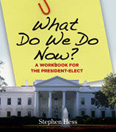 |
Stephen
Hess. Nov. 2008. WHAT DO WE DO NOW?: A Workbook for
the President-elect. Washington, DC: Brookings
Institution Press.
"In
What Do We Do Now?
Stephen Hess
draws from his long experience as a White House staffer and
presidential adviser to show what can be done to make presidential
transitions go smoothly. Here is a workbook to guide future chief
executives, decision by decision, through the minefield of transition.
You’ll have to start at the beginning, settling on a management style
and knowing how to “arrange all the boxes.” Something as seemingly
mundane as parceling office space can be consequential—hence the
inclusion of a proposed White House organizational chart and floor
plans of the West Wing. What qualities are needed for each job, and
where are the best candidates for those positions most likely to be
found? How can you construct a cabinet that “looks like America”? What
Do We Do Now? is your indispensable guide through the thicket of these
decisions." |
|
|
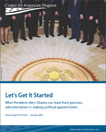 |
Anne Joseph O’Connell. Jan. 15,
2009. LET'S GET IT
STARTED: What President-Elect Obama Can Learn from Previous
Administrations in Making Political Appointments.
Washington, DC: Center
for American Progress.
"If President-elect
Obama follows the example of recent presidents, he will finalize his
initial top picks for the cabinet and heads of other major agencies by
Inauguration Day but will take much longer to select individuals for
lower layers of the bureaucracy. Staffing these lower but still
critical positions is remarkably challenging. It takes many months to
get the first wave of appointees into the bureaucracy. Once filled,
these positions do not stay occupied for long. And near the end of a
term or administration, these political positions empty out yet
again... This report analyzes comprehensive new data on delays in the
appointments process as well as appointee turnover in Senate-confirmed
positions in executive agencies over the past five administrations." +
|
|
|
 |
Mark Green and Michele Jolin, eds. Jan. 15,
2009. CHANGE FOR
AMERICA: A Progressive
Blueprint for the 44th President. New York: Basic Books.
"Change for America: A Progressive
Blueprint for the 44th President is a framework to help the next
administration steer the government in a new, more progressive
direction." The Center for American Progress is
releasing this book on Nov. 12, 2008. (John Podesta, one of the
co-chairs of the transition is president and CEO of the Center for
American Progress). Co-editor Michele Jolin is a senior fellow at
the Center for American Progress Action Fund; co-editor Mark Green is
founder and president of New Democracy Project. |
|
|
 |
Robert Kuttner.
Aug. 28, 2008. OBAMA'S
CHALLENGE: America's
Economic Crisis and the Power of a Transformative Presidency.
White River Junction,
VT: Chelsea
Green Publishing.
"Barack
Obama approaches the Presidency at a critical moment in American
history, facing simultaneous crises of war, the environment, health
care, but most especially in the economy. If he is able to rise to the
moment, he could join the ranks of a small handful of previous
presidents who have been truly transformative, succeeding in
fundamentally changing our economy, society, and democracy for the
better. But this will require imaginative and decisive action as
Obama takes office, action bolder than he has promised during his
campaign, and will be all the more difficult given the undertow of
conventional wisdom in Washington and on Wall Street that resists
fundamental change."
|
|

|
Government Accountability
Office: 2009 Congressional and Presidential Transition
[www.gao.gov/transition_2009]
"Following
each presidential election, GAO serves as a resource to
assist with the transition to a new Congress and administration. On
this Web site, using its institutional knowledge and broad-based,
nonpartisan work on matters across the government spectrum, GAO
provides insight into, and recommendations for addressing, the nation’s
major issues, risks and challenges. Also located throughout the site
are key reports for further research, as well as contact information
for and video messages from GAO experts." >
|
|
|
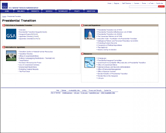 |
U.S.
General
Services Administration: Presidential Transition
[www.gsa.gov/Portal/gsa/ep/home.do?tabId=15]
The GSA provides a range of services for the President-elect and Vice
President-elect as well as for the outgoing administration, including
everything from office space to communications and computer systems.
|
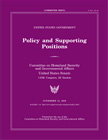 |
U.S. Senate Committee on Governmental
Affairs. Nov. 12, 2008. Policy and
Supporting Positions.
Washington, DC: U.S.
Government Printing Office.
"Published by the Senate Committee on Governmental Affairs and the
House Committee on Government Reform alternately after each
Presidential election, the Plum Book lists over 7,000 Federal civil
service leadership and support positions in the legislative and
executive branches of the Federal Government that may be subject to
noncompetitive appointment, nationwide. Data covers positions such as
agency heads and their immediate subordinates, policy executives and
advisors, and aides who report to these officials." |
United
States Senate. "Managing
the Challenges of the Federal Government Transition." Hearing
before the U.S. Senate Committee on Homeland Security and Governmental
Affairs, Subcommittee on Oversight of Government Management, the
Federal Workforce, and the District of Columbia. Sept. 10, 2008.
Out
With the Old
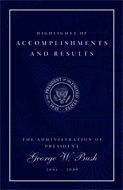 |
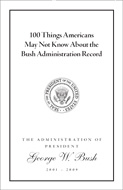 |
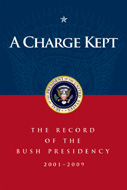 |
Executive Office of the President
published Jan. 2009:
A
Charge Kept: The Record of the Bush Presidency, 2001-2009
(129 pages)
published Dec. 2008:
Highlights
of Accomplishments and Results of the Administration of George W. Bush
(50 pages incl. 26 color photos)
100
Things Americans May Not Know About the Bush Administration Record
(40 page appendix)
+
|
General Transition
Martha Joynt Kumar and Terry
Sullivan , eds. Feb. 2003. THE WHITE HOUSE WORLD:
Transitions, Organization, and Office Operations (Joseph V.
Hughes, Jr., and Holly O. Hughes Series in the Presidency and
Leadership Studies, No. 13). Texas A&M University Press.
John P. Burke. Sept.
2000. PRESIDENTIAL
TRANSITIONS: From Politics to Practice. Lynne Rienner
Publishers.
Carl M. Brauer. Dec.
1988. PRESIDENTIAL
TRANSITIONS: Eisenhower through Reagan. Oxford University
Press.
June 2002. THE WHITE HOUSE:
Allegations of Damage During the 2001 Presidential Transition
(GAO-02-360). U.S. General Accountability Office.
The
Transition to Governing
Project (AEI, Brookings and
Hoover project on the 2000-01 transition).
 |
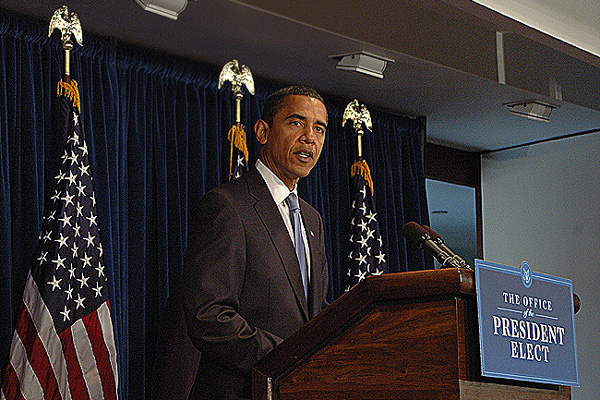 |
BACK
|
BUILDING THE NEW ADMINISTRATION - JAN. 2009
|
NEXT
|
|
| Copyright
© 2006, 2007, 2008, 2009 Eric M. Appleman/Democracy in Action |

|











